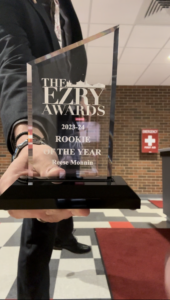Drawing largely from the 2003 play by Sarah Ruhl, the Wittenberg Theatre Department’s rendition of “Eurydice” opened the department’s 2017-2018 season last weekend.
Blending bold directional choices with an unconventional storytelling style, the production wove a unique and delicate take on the classic Greek myth.
While performance was technically excellent, the minimalistic storytelling style eventually left the audience disoriented and unsure of what message to take from it.
The story follows Eurydice, a woman who is killed on her wedding night. After traveling to the Underworld, she is met by her father, who managed to sidestep the process of “forgetting” which occurs after death. While he retells her life story and accustoms her to the afterlife, Eurydice’s husband searches for a way to resurrect her.
Despite a slow, awkward start, plot developments throughout kept the audience engaged and invested in the characters, especially the relationship between Eurydice and her father, which verged on unsettlingly close contact at moments during their time together.
The subject matter was undoubtedly heavy and kept the audience on the brink of tears for most of the performance. Brief moments of humor kept viewers afloat, but the play’s dark, unsettling nature was eventually its greatest flaw, despite being a major theme. The emotional connections between characters, though, served mostly to redeem the uneasy feeling that prevailed throughout, and gave audience members something to tie their allegiances to, as they were certain not to find it in the Underworld.
The production’s character design and acting were stellar, especially the performance of star Olivia Zink, ‘19, who played titular Eurydice, Carson Betts, ‘18, who played Eurydice’s father, and the three Stones, Drake Kobler, ‘21, Taylor Oberschake, ‘20 and Sam Bailey, ‘20. Zink perfectly captured a lighthearted character in the midst of her own demise, while Betts personified a father struggling with the untimely death of his daughter. The three Stones, assistants to the so-called Dark Overlord of the Underworld (played by Morgan Beechey, ‘18), provided structure to the depressing, unsettling feeling of the Underworld and lightened the heavy mood with shining moments of humor, proving themselves highlights of the performance.
Having only one set to work with, the production crew did a remarkable job of making malleable the relatively bleak stage scene. Lighting changes, doors and props served to divide the stage area into multiple scenes, which allowed characters in multiple locations to move around at once. So too, the large red doors that served as the “elevator” into the Underworld were accompanied by fantastically unique beads that emulated rain drops as they fell from above the heads of those exiting the elevator, also enhancing the unseen visual of the River Styx, the body of water that causes the dead to forget their past lives. Each set piece was simple and small, yet dramatically impacted the audience’s perceptions of the presence of the stage.
Again touting their chops as minimalist storytellers, the crew used only a handful of props to enhance the performance, which bolstered the image of the bleak, dismal world of Hades. The most impressive of which, the house actor Betts created live onstage using only an umbrella, string and rocks, created a set within a set that gave the actors a sense of place onstage and the audience a sense of setting. The accent pieces of the Overlord’s pink tricycle and the piano in the opening sequence served also to lighten the mood and give the audience an occasional moment of levity. Meanwhile, the letters and their passing between the Underworld created an emotional anchor for the audience
The costumes and makeup were simple and effective, unique to each character. Those in the Underworld wore drab, grey and white-toned colors, while the emotional musician and husband of Eurydice, Orpheus, wore much a brighter, colorful wardrobe. The over-exaggerated, cartoony outfits of both the Interesting Man and the Overlord (both played by Beechey) provided moments of levity comparable to the design of their characters.
Serving hand-in-hand to distinguish transitions, the production’s lighting and sound molded and enhanced the drab, uneasy feeling elicited by the Underworld and its inhabitants. Each time the audience’s focus was drawn back into the Underworld, a haunting, echoing drop of water would reverberate around the room for a moment, and the lights would slowly illuminate the stage, revealing characters in a different position than they were left in. Although some issues arose with syncing audio between the sound board and the actors arose, most audiovisual stunts went off without a hitch and painted a more immersive picture of the scenery for the audience.
Most of the play’s minimalist technical design accompanied and even mirrored the story elements: the plot progressed slowly but surely, and kept audiences in the dark about anything not immediately relevant to the actions of each character in a given moment. Every aspect of the storytelling was quirky and out-of-the-box, also promoting the intended unsettling atmosphere. At times, though, the storytelling was too odd; the audience was sure that it was supposed to have learned something about the nature of death and memory, but it was unsure of what the moral message was supposed to be, as that aspect was unintentionally drowned out by a desire by the production to be as simple and imaginative as possible.
All things considered, the Wittenberg Theatre Department’s production of “Eurydice” was a well-produced, well-executed piece of theatre, despite the fact that its ambiance and quirky nature left the audience without a clear moral to take away. It was memorable, interesting, unsettling, well worth watching and an excellent springboard for the rest of the department’s season.





